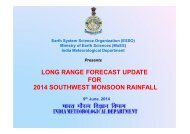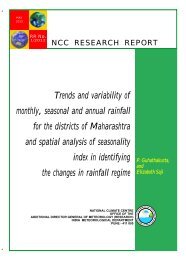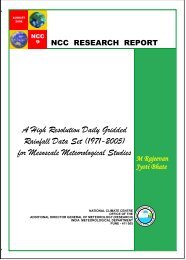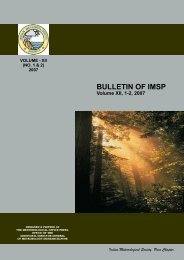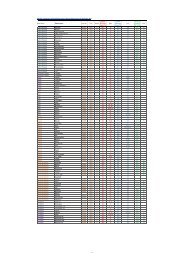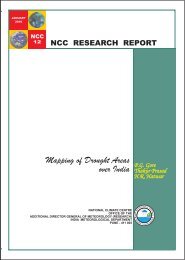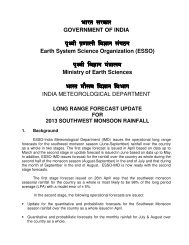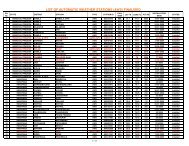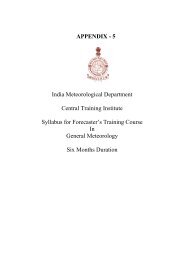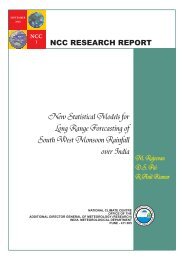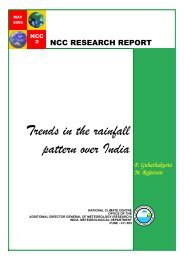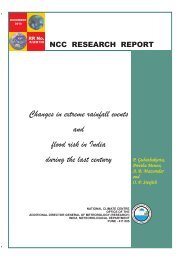Met.Monograph on SW Monsoon - (IMD), Pune
Met.Monograph on SW Monsoon - (IMD), Pune
Met.Monograph on SW Monsoon - (IMD), Pune
Create successful ePaper yourself
Turn your PDF publications into a flip-book with our unique Google optimized e-Paper software.
26 Southwest M<strong>on</strong>so<strong>on</strong>2.8.5 Temperature and wind data are too scanty to reliably picture the vertical circulati<strong>on</strong> nearthe jet stream. The same is the case regarding diffluence and c<strong>on</strong>fluence in the jet stream. Thedirecti<strong>on</strong> of winds at 100 mb is with in five degrees of 85° at places to the south of 23° N.2.8.6 In June, Madras, Port Blair, Nagpur and Bombay show increase in the speed of theeasterlies from 9 to 16 km. Trivandrum shows maximum speed of 65 kt at 14 km, speed beinghigher than at Madras at this level. Ambala has fairly str<strong>on</strong>g westerlies between 14 and 18 km.Between 25° and 30° N, westerlies occur at some stati<strong>on</strong>s at 14 km and even at 16 km. Easterlieswhich appear at 18 km at Delhi are weak. The Easterly Jet in June is thus c<strong>on</strong>fined to a little moresoutherly latitude and is also at a higher level in the Peninsula than in July. Speeds are less to thenorth of 15° N in June but more at some levels to the south.2.8.7 C<strong>on</strong>diti<strong>on</strong>s in August are similar to July. In September, str<strong>on</strong>g easterlies are c<strong>on</strong>fined tosouth of about 21° N; speeds are less and westerlies appear at levels like 14 km north of 25° N. AtMinicoy a maximum speed of 45 kt is at 14 km.2.9 Meridi<strong>on</strong>al Circulati<strong>on</strong>2.9.1 Mean meridi<strong>on</strong>al comp<strong>on</strong>ents are usually weaker than the z<strong>on</strong>al winds and are notprominently seen in the mean wind charts. In view of their importance for exchange of heat,momentum etc. between different latitudes, meridi<strong>on</strong>al circulati<strong>on</strong> over India is separatelydiscussed.2.9.2 Rao (1962) has studied in detail the meridi<strong>on</strong>al circulati<strong>on</strong> associated with southwestm<strong>on</strong>so<strong>on</strong>. The mean meridi<strong>on</strong>al comp<strong>on</strong>ents for July at rawin stati<strong>on</strong>s over India are shown in Fig.2.14. Except at Trivandrum and Nagpur, at all stati<strong>on</strong>s right upto 32° N, there is flow from south inthe lower troposphere; aloft, the flow is from north, except in northwest India (Jodhpur, Delhi andAmritsar). At these places, the flow from north in mid-troposphere is capped by flow from southagain in upper troposphere. From these, we may picture that to the south of 25° N, there ism<strong>on</strong>so<strong>on</strong>al meridi<strong>on</strong>al circulati<strong>on</strong> with southerlies below and northerlies aloft. To the north of 25°N latitude, such a m<strong>on</strong>so<strong>on</strong> circulati<strong>on</strong> is c<strong>on</strong>fined to the lower part of troposphere with the HadleyCell circulati<strong>on</strong> aloft. The northerlies at surface at Trivandrum are induced partly by the air flowaround the southern tip of the western ghats and the presence of a clockwise circulati<strong>on</strong> just south ofthe equator in lower troposphere at 70° E.2.9.3 Figure 2.15 presents a vertical cross-secti<strong>on</strong> of the mean meridi<strong>on</strong>al comp<strong>on</strong>ents for themean Indian l<strong>on</strong>gitude in January and July. In January, over India to the south of about 30° N,northerlies of the direct cell prevail from the surface upto 300 mb and southerlies aloft. Towards theequator these meridi<strong>on</strong>al comp<strong>on</strong>ents are str<strong>on</strong>ger, much to the south of the centre (12 N) of thedirect cell as found <strong>on</strong> global scale. Two types of direct circulati<strong>on</strong> have been recognised. Of these,the type associated with the predominant easterly trades has a layer of southerlies at the middle ofthe general northerlies, the main layer of southerlies being much higher above. Indian data inJanuary also show either weak southerlies or weakening of northerlies at the middle of the layer ofnortherlies. Al<strong>on</strong>g 50°E, upper tropospheric southerlies are absent at Aden and Bahrain wherenortherlies reach upto the tropopause.2.9.4 In July (Fig. 2.15) between 12°N and 26°N a simple circulati<strong>on</strong> of southerlies belowand northerlies aloft is found over the Indian regi<strong>on</strong>, which may be called the 'm<strong>on</strong>so<strong>on</strong> cell’. Theusual direct cell is very much shrunk in its latitudinal extent and is seen <strong>on</strong>ly between 25° and 40°N. Its presence at 30° N is clear from the northerlies in mid-troposphere and southerlies aloft,though weak southerlies of the m<strong>on</strong>so<strong>on</strong> cell extend so far northwards (i.e. upto 30° N) in thelowest layers of the troposphere. In this m<strong>on</strong>th, Aden and Bahrein exhibit both the lowertropospheric northerlies and upper tropospheric southerlies of the direct cell.



